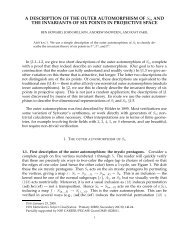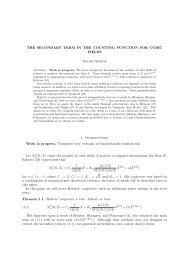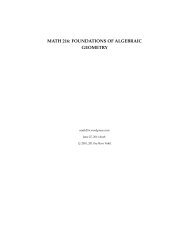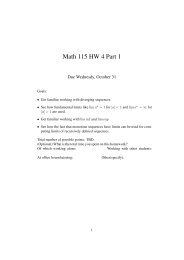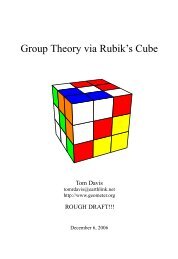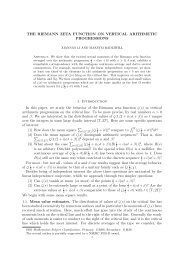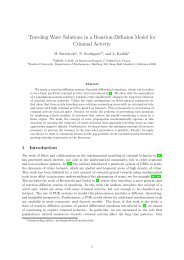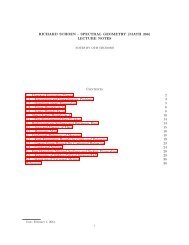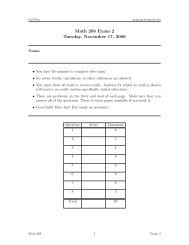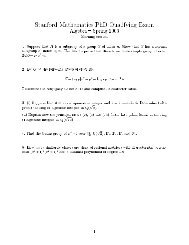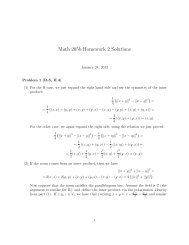- Page 1: MATH 216: FOUNDATIONS OF ALGEBRAIC
- Page 4 and 5: 5.5. Projective schemes, and the Pr
- Page 6 and 7: 19.1. Motivating example: blowing u
- Page 9 and 10: CHAPTER 1 Introduction I can illust
- Page 11: April 4, 2012 draft 11 into thinkin
- Page 15 and 16: CHAPTER 2 Some category theory That
- Page 17 and 18: April 4, 2012 draft 17 the universa
- Page 19 and 20: April 4, 2012 draft 19 2.2.7. Examp
- Page 21 and 22: April 4, 2012 draft 21 It is wise t
- Page 23 and 24: April 4, 2012 draft 23 made using t
- Page 25 and 26: April 4, 2012 draft 25 2.3.E. EXERC
- Page 27 and 28: April 4, 2012 draft 27 2.3.6. Essen
- Page 29 and 30: diagram April 4, 2012 draft 29 ≤1
- Page 31 and 32: April 4, 2012 draft 31 2.4 Limits a
- Page 33 and 34: April 4, 2012 draft 33 Even though
- Page 35 and 36: we require (2.5.0.2) MorB(F(A ′ )
- Page 37 and 38: April 4, 2012 draft 37 and S is a m
- Page 39: April 4, 2012 draft 39 2.6.2. Remar
- Page 43 and 44: April 4, 2012 draft 43 2.6.6. Theor
- Page 45 and 46: April 4, 2012 draft 45 obvious to y
- Page 47 and 48: April 4, 2012 draft 47 is an exact
- Page 49 and 50: April 4, 2012 draft 49 The order of
- Page 51 and 52: April 4, 2012 draft 51 arrowheads a
- Page 53 and 54: April 4, 2012 draft 53 Lemma! (Noti
- Page 55 and 56: April 4, 2012 draft 55 2.7.8. Goals
- Page 57 and 58: 2.7.10. Defining E p,q r . Define X
- Page 59: April 4, 2012 draft 59 This complet
- Page 62 and 63: 62 Math 216: Foundations of Algebra
- Page 64 and 65: 64 Math 216: Foundations of Algebra
- Page 66 and 67: 66 Math 216: Foundations of Algebra
- Page 68 and 69: 68 Math 216: Foundations of Algebra
- Page 70 and 71: 70 Math 216: Foundations of Algebra
- Page 72 and 73: 72 Math 216: Foundations of Algebra
- Page 74 and 75: 74 Math 216: Foundations of Algebra
- Page 76 and 77: 76 Math 216: Foundations of Algebra
- Page 78 and 79: 78 Math 216: Foundations of Algebra
- Page 80 and 81: 80 Math 216: Foundations of Algebra
- Page 82 and 83: 82 Math 216: Foundations of Algebra
- Page 84 and 85: 84 Math 216: Foundations of Algebra
- Page 87: Part II Schemes
- Page 90 and 91:
90 Math 216: Foundations of Algebra
- Page 92 and 93:
92 Math 216: Foundations of Algebra
- Page 94 and 95:
94 Math 216: Foundations of Algebra
- Page 96 and 97:
96 Math 216: Foundations of Algebra
- Page 98 and 99:
98 Math 216: Foundations of Algebra
- Page 100 and 101:
100 Math 216: Foundations of Algebr
- Page 102 and 103:
102 Math 216: Foundations of Algebr
- Page 104 and 105:
104 Math 216: Foundations of Algebr
- Page 106 and 107:
106 Math 216: Foundations of Algebr
- Page 108 and 109:
108 Math 216: Foundations of Algebr
- Page 110 and 111:
110 Math 216: Foundations of Algebr
- Page 112 and 113:
112 Math 216: Foundations of Algebr
- Page 114 and 115:
114 Math 216: Foundations of Algebr
- Page 116 and 117:
116 Math 216: Foundations of Algebr
- Page 118 and 119:
118 Math 216: Foundations of Algebr
- Page 120 and 121:
120 Math 216: Foundations of Algebr
- Page 122 and 123:
122 Math 216: Foundations of Algebr
- Page 124 and 125:
124 Math 216: Foundations of Algebr
- Page 126 and 127:
126 Math 216: Foundations of Algebr
- Page 128 and 129:
128 Math 216: Foundations of Algebr
- Page 130 and 131:
130 Math 216: Foundations of Algebr
- Page 132 and 133:
132 Math 216: Foundations of Algebr
- Page 134 and 135:
134 Math 216: Foundations of Algebr
- Page 136 and 137:
136 Math 216: Foundations of Algebr
- Page 138 and 139:
138 Math 216: Foundations of Algebr
- Page 141 and 142:
CHAPTER 6 Some properties of scheme
- Page 143 and 144:
April 4, 2012 draft 143 6.1.2. Dime
- Page 145 and 146:
April 4, 2012 draft 145 6.3.1. Prop
- Page 147 and 148:
April 4, 2012 draft 147 6.3.5. Unim
- Page 149 and 150:
April 4, 2012 draft 149 irreducible
- Page 151 and 152:
April 4, 2012 draft 151 6.4.5. Thus
- Page 153 and 154:
April 4, 2012 draft 153 that Z[ √
- Page 155 and 156:
The next property makes (A) more st
- Page 157 and 158:
April 4, 2012 draft 157 6.5.G. EXER
- Page 159 and 160:
We prove Theorem 6.5.6 in a series
- Page 161:
Part III Morphisms of schemes
- Page 164 and 165:
164 Math 216: Foundations of Algebr
- Page 166 and 167:
166 Math 216: Foundations of Algebr
- Page 168 and 169:
168 Math 216: Foundations of Algebr
- Page 170 and 171:
170 Math 216: Foundations of Algebr
- Page 172 and 173:
172 Math 216: Foundations of Algebr
- Page 174 and 175:
174 Math 216: Foundations of Algebr
- Page 176 and 177:
176 Math 216: Foundations of Algebr
- Page 178 and 179:
178 Math 216: Foundations of Algebr
- Page 180 and 181:
180 Math 216: Foundations of Algebr
- Page 182 and 183:
182 Math 216: Foundations of Algebr
- Page 184 and 185:
184 Math 216: Foundations of Algebr
- Page 186 and 187:
186 Math 216: Foundations of Algebr
- Page 188 and 189:
188 Math 216: Foundations of Algebr
- Page 190 and 191:
190 Math 216: Foundations of Algebr
- Page 192 and 193:
192 Math 216: Foundations of Algebr
- Page 194 and 195:
194 Math 216: Foundations of Algebr
- Page 196 and 197:
196 Math 216: Foundations of Algebr
- Page 198 and 199:
198 Math 216: Foundations of Algebr
- Page 200 and 201:
200 Math 216: Foundations of Algebr
- Page 202 and 203:
202 Math 216: Foundations of Algebr
- Page 204 and 205:
204 Math 216: Foundations of Algebr
- Page 207 and 208:
CHAPTER 9 Closed embeddings and rel
- Page 209 and 210:
April 4, 2012 draft 209 closed. (ii
- Page 211 and 212:
April 4, 2012 draft 211 FIGURE 9.1.
- Page 213 and 214:
April 4, 2012 draft 213 P3 k . In f
- Page 215 and 216:
April 4, 2012 draft 215 (perhaps no
- Page 217 and 218:
April 4, 2012 draft 217 FIGURE 9.3.
- Page 219 and 220:
April 4, 2012 draft 219 Example 4.
- Page 221:
April 4, 2012 draft 221 “p to p
- Page 224 and 225:
224 Math 216: Foundations of Algebr
- Page 226 and 227:
226 Math 216: Foundations of Algebr
- Page 228 and 229:
228 Math 216: Foundations of Algebr
- Page 230 and 231:
230 Math 216: Foundations of Algebr
- Page 232 and 233:
232 Math 216: Foundations of Algebr
- Page 234 and 235:
234 Math 216: Foundations of Algebr
- Page 236 and 237:
236 Math 216: Foundations of Algebr
- Page 238 and 239:
238 Math 216: Foundations of Algebr
- Page 240 and 241:
240 Math 216: Foundations of Algebr
- Page 242 and 243:
242 Math 216: Foundations of Algebr
- Page 244 and 245:
244 Math 216: Foundations of Algebr
- Page 246 and 247:
246 Math 216: Foundations of Algebr
- Page 248 and 249:
248 Math 216: Foundations of Algebr
- Page 250 and 251:
250 Math 216: Foundations of Algebr
- Page 252 and 253:
252 Math 216: Foundations of Algebr
- Page 254 and 255:
254 Math 216: Foundations of Algebr
- Page 256 and 257:
256 Math 216: Foundations of Algebr
- Page 258 and 259:
258 Math 216: Foundations of Algebr
- Page 260 and 261:
260 Math 216: Foundations of Algebr
- Page 262 and 263:
262 Math 216: Foundations of Algebr
- Page 264 and 265:
264 Math 216: Foundations of Algebr
- Page 266 and 267:
266 Math 216: Foundations of Algebr
- Page 268 and 269:
268 Math 216: Foundations of Algebr
- Page 271:
Part IV Harder properties of scheme
- Page 274 and 275:
274 Math 216: Foundations of Algebr
- Page 276 and 277:
276 Math 216: Foundations of Algebr
- Page 278 and 279:
278 Math 216: Foundations of Algebr
- Page 280 and 281:
280 Math 216: Foundations of Algebr
- Page 282 and 283:
282 Math 216: Foundations of Algebr
- Page 284 and 285:
284 Math 216: Foundations of Algebr
- Page 286 and 287:
286 Math 216: Foundations of Algebr
- Page 288 and 289:
288 Math 216: Foundations of Algebr
- Page 290 and 291:
290 Math 216: Foundations of Algebr
- Page 292 and 293:
292 Math 216: Foundations of Algebr
- Page 294 and 295:
294 Math 216: Foundations of Algebr
- Page 296 and 297:
296 Math 216: Foundations of Algebr
- Page 298 and 299:
298 Math 216: Foundations of Algebr
- Page 300 and 301:
300 Math 216: Foundations of Algebr
- Page 302 and 303:
302 Math 216: Foundations of Algebr
- Page 304 and 305:
304 Math 216: Foundations of Algebr
- Page 306 and 307:
306 Math 216: Foundations of Algebr
- Page 308 and 309:
308 Math 216: Foundations of Algebr
- Page 310 and 311:
310 Math 216: Foundations of Algebr
- Page 312 and 313:
312 Math 216: Foundations of Algebr
- Page 314 and 315:
314 Math 216: Foundations of Algebr
- Page 316 and 317:
316 Math 216: Foundations of Algebr
- Page 318 and 319:
318 Math 216: Foundations of Algebr
- Page 320 and 321:
320 Math 216: Foundations of Algebr
- Page 322 and 323:
322 Math 216: Foundations of Algebr
- Page 325:
Part V Quasicoherent sheaves
- Page 328 and 329:
328 Math 216: Foundations of Algebr
- Page 330 and 331:
330 Math 216: Foundations of Algebr
- Page 332 and 333:
332 Math 216: Foundations of Algebr
- Page 334 and 335:
334 Math 216: Foundations of Algebr
- Page 336 and 337:
336 Math 216: Foundations of Algebr
- Page 338 and 339:
338 Math 216: Foundations of Algebr
- Page 340 and 341:
340 Math 216: Foundations of Algebr
- Page 342 and 343:
342 Math 216: Foundations of Algebr
- Page 344 and 345:
344 Math 216: Foundations of Algebr
- Page 346 and 347:
346 Math 216: Foundations of Algebr
- Page 348 and 349:
348 Math 216: Foundations of Algebr
- Page 350 and 351:
350 Math 216: Foundations of Algebr
- Page 352 and 353:
352 Math 216: Foundations of Algebr
- Page 354 and 355:
354 Math 216: Foundations of Algebr
- Page 356 and 357:
356 Math 216: Foundations of Algebr
- Page 358 and 359:
358 Math 216: Foundations of Algebr
- Page 360 and 361:
360 Math 216: Foundations of Algebr
- Page 362 and 363:
362 Math 216: Foundations of Algebr
- Page 364 and 365:
364 Math 216: Foundations of Algebr
- Page 366 and 367:
366 Math 216: Foundations of Algebr
- Page 368 and 369:
368 Math 216: Foundations of Algebr
- Page 370 and 371:
370 Math 216: Foundations of Algebr
- Page 372 and 373:
372 Math 216: Foundations of Algebr
- Page 375 and 376:
CHAPTER 17 Pushforwards and pullbac
- Page 377 and 378:
April 4, 2012 draft 377 The similar
- Page 379 and 380:
April 4, 2012 draft 379 (π ∗ G )
- Page 381 and 382:
April 4, 2012 draft 381 pullback of
- Page 383 and 384:
April 4, 2012 draft 383 Every time
- Page 385 and 386:
April 4, 2012 draft 385 of π : P 1
- Page 387 and 388:
April 4, 2012 draft 387 We next wa
- Page 389 and 390:
April 4, 2012 draft 389 We next red
- Page 391 and 392:
April 4, 2012 draft 391 [EGA, III1.
- Page 393 and 394:
April 4, 2012 draft 393 cover of (q
- Page 395 and 396:
April 4, 2012 draft 395 see a key e
- Page 397 and 398:
CHAPTER 18 Relative versions of Spe
- Page 399 and 400:
April 4, 2012 draft 399 18.1.D. EXE
- Page 401 and 402:
April 4, 2012 draft 401 Show that t
- Page 403 and 404:
April 4, 2012 draft 403 as Proj S
- Page 405 and 406:
finite type quasicoherent sheaves.
- Page 407 and 408:
April 4, 2012 draft 407 quasicohere
- Page 409 and 410:
April 4, 2012 draft 409 namely X).
- Page 411 and 412:
April 4, 2012 draft 411 18.4.A. EXE
- Page 413 and 414:
April 4, 2012 draft 413 (b) Suppose
- Page 415 and 416:
CHAPTER 19 ⋆ Blowing up a scheme
- Page 417 and 418:
April 4, 2012 draft 417 which lets
- Page 419 and 420:
April 4, 2012 draft 419 Spec A. (A
- Page 421 and 422:
April 4, 2012 draft 421 given by xi
- Page 423 and 424:
April 4, 2012 draft 423 to you (in
- Page 425 and 426:
April 4, 2012 draft 425 family is
- Page 427 and 428:
April 4, 2012 draft 427 that the no
- Page 429 and 430:
April 4, 2012 draft 429 rational ma
- Page 431:
April 4, 2012 draft 431 (cf. §19.3
- Page 434 and 435:
434 Math 216: Foundations of Algebr
- Page 436 and 437:
436 Math 216: Foundations of Algebr
- Page 438 and 439:
438 Math 216: Foundations of Algebr
- Page 440 and 441:
440 Math 216: Foundations of Algebr
- Page 442 and 443:
442 Math 216: Foundations of Algebr
- Page 444 and 445:
444 Math 216: Foundations of Algebr
- Page 446 and 447:
446 Math 216: Foundations of Algebr
- Page 448 and 449:
448 Math 216: Foundations of Algebr
- Page 450 and 451:
450 Math 216: Foundations of Algebr
- Page 452 and 453:
452 Math 216: Foundations of Algebr
- Page 454 and 455:
454 Math 216: Foundations of Algebr
- Page 456 and 457:
456 Math 216: Foundations of Algebr
- Page 458 and 459:
458 Math 216: Foundations of Algebr
- Page 460 and 461:
460 Math 216: Foundations of Algebr
- Page 462 and 463:
462 Math 216: Foundations of Algebr
- Page 464 and 465:
464 Math 216: Foundations of Algebr
- Page 466 and 467:
466 Math 216: Foundations of Algebr
- Page 468 and 469:
468 Math 216: Foundations of Algebr
- Page 470 and 471:
470 Math 216: Foundations of Algebr
- Page 472 and 473:
472 Math 216: Foundations of Algebr
- Page 474 and 475:
474 Math 216: Foundations of Algebr
- Page 476 and 477:
476 Math 216: Foundations of Algebr
- Page 478 and 479:
478 Math 216: Foundations of Algebr
- Page 480 and 481:
480 Math 216: Foundations of Algebr
- Page 482 and 483:
482 Math 216: Foundations of Algebr
- Page 484 and 485:
484 Math 216: Foundations of Algebr
- Page 486 and 487:
486 Math 216: Foundations of Algebr
- Page 488 and 489:
488 Math 216: Foundations of Algebr
- Page 490 and 491:
490 Math 216: Foundations of Algebr
- Page 492 and 493:
492 Math 216: Foundations of Algebr
- Page 494 and 495:
494 Math 216: Foundations of Algebr
- Page 496 and 497:
496 Math 216: Foundations of Algebr
- Page 498 and 499:
498 Math 216: Foundations of Algebr
- Page 500 and 501:
500 Math 216: Foundations of Algebr
- Page 502 and 503:
502 Math 216: Foundations of Algebr
- Page 504 and 505:
504 Math 216: Foundations of Algebr
- Page 506 and 507:
506 Math 216: Foundations of Algebr
- Page 508 and 509:
508 Math 216: Foundations of Algebr
- Page 510 and 511:
510 Math 216: Foundations of Algebr
- Page 512 and 513:
512 Math 216: Foundations of Algebr
- Page 514 and 515:
514 Math 216: Foundations of Algebr
- Page 516 and 517:
516 Math 216: Foundations of Algebr
- Page 518 and 519:
518 Math 216: Foundations of Algebr
- Page 520 and 521:
520 Math 216: Foundations of Algebr
- Page 522 and 523:
522 Math 216: Foundations of Algebr
- Page 524 and 525:
524 Math 216: Foundations of Algebr
- Page 526 and 527:
526 Math 216: Foundations of Algebr
- Page 528 and 529:
528 Math 216: Foundations of Algebr
- Page 530 and 531:
530 Math 216: Foundations of Algebr
- Page 532 and 533:
532 Math 216: Foundations of Algebr
- Page 534 and 535:
534 Math 216: Foundations of Algebr
- Page 536 and 537:
536 Math 216: Foundations of Algebr
- Page 538 and 539:
538 Math 216: Foundations of Algebr
- Page 541:
Part VI More
- Page 544 and 545:
544 we hope M ⊗A N ′ → M ⊗A
- Page 546 and 547:
546 Proof. Given a short exact sequ
- Page 548 and 549:
548 products to products (a consequ
- Page 550 and 551:
550 24.3.C. EXERCISE. Show that you
- Page 552 and 553:
552 Suppose · · · → C p−1
- Page 554 and 555:
554 Exercise 24.3.D describes what
- Page 556 and 557:
556 — Z U (V) = Z if V ⊂ U, and
- Page 558 and 559:
558 Then we take cohomology in the
- Page 560 and 561:
560 Prove this by endowing X with t
- Page 563 and 564:
CHAPTER 25 Flatness The concept of
- Page 565 and 566:
• In §25.2, we discuss some of t
- Page 567 and 568:
Motivated by Proposition 25.2.3, th
- Page 569 and 570:
the same idea as the proof of Theor
- Page 571 and 572:
(b) If M ′ and M ′′ are both
- Page 573 and 574:
is everything. As M is finitely pre
- Page 575 and 576:
25.4.K. EXERCISE. Suppose (with the
- Page 577 and 578:
y 2 . Then show that t is not a zer
- Page 579 and 580:
(c) Recall the Going-Up Theorem, de
- Page 581 and 582:
25.6 Local criteria for flatness (T
- Page 583 and 584:
t is a non-zerodivisor on B. Then M
- Page 585 and 586:
Proof. The question is local on the
- Page 587 and 588:
In §17.4.8, we produced a proper n
- Page 589 and 590:
25.8.1. Semicontinuity theorem. —
- Page 591 and 592:
pullback: given a fibered square (2
- Page 593 and 594:
we will give a new proof of Theorem
- Page 595 and 596:
25.9.C. EXERCISE. (a) Describe a ma
- Page 597 and 598:
25.9.K. EXERCISE. Put all the piece
- Page 599 and 600:
CHAPTER 29 Twenty-seven lines 29.1
- Page 601 and 602:
(29.2.0.1) if and only if (29.2.0.2
- Page 603 and 604:
involving precisely one x or y surv
- Page 605 and 606:
29.4.B. EXERCISE. Show that the bir
- Page 607 and 608:
CHAPTER 30 ⋆ Proof of Serre duali
- Page 609 and 610:
30.2.A. EXERCISE. Suppose F = O(m).
- Page 611 and 612:
and consider the spectral sequence
- Page 613 and 614:
where in the middle term, the “a
- Page 615 and 616:
By Exercise 30.3.H again, then stro
- Page 617 and 618:
30.4.B. EXERCISE (STRONG SERRE DUAL
- Page 619 and 620:
Bibliography [ACGH] E. Arbarello, M
- Page 621 and 622:
0-ring, 11 A-scheme, 147 A[[x]], 11
- Page 623 and 624:
Cohen-Seidenberg Lying Over Theorem
- Page 625 and 626:
generic fiber, 575 generic point, 1
- Page 627 and 628:
Noetherian module, 114 Noetherian r
- Page 629 and 630:
Serre duality (strong form), 634 Se



